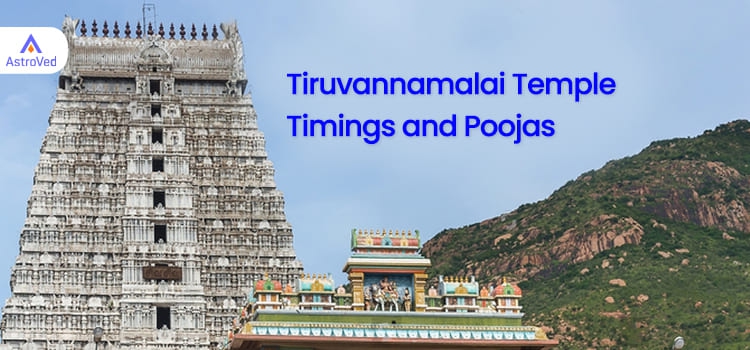Tiruvannamalai Temple Timings and Poojas
Tiruvannamalai Temple Timings and Poojas
Tiruvannamalai is one of the holiest places in Tamil Nadu. In earlier days, “Annamalai” meant ‘inaccessible mountain’. The word “Thiru” indicates its greatness.
This temple town is one of the most ancient heritage sites in India. It is also a Shaivite center. Tamils hold the Arunachala hill and its environs in high regard.
The main attraction in Tiruvannamalai is the Arunachaleshwarar temple, also called Annamalaiyar temple. One of the famed Panchabhootha Sthalas dedicated to Lord Shiva, the temple represents Agni (Fire element). Both in its conception and architecture, the Annamalaiyar Temple evokes grandeur. It is rich in tradition and history and celebrates many festivals. Karthigai Deepam festival, the most important of these, attracts devotees from all over South India.

Legend behind Tiruvannamalai temple
The story goes that once, Goddess Parvati, the consort of Lord Shiva, closed his eyes playfully while they were in a flower garden at their heavenly abode atop Mount Kailas. When she did this, the entire universe plunged into darkness for years. Shiva was extremely annoyed by Parvati’s prank. So, she performed penance along with other Shiva devotees. Pleased, Shiva appeared as a big column of fire atop Annamalai hills, and light returned to the world. Then he merged with Parvati to become Ardanarishvara, the androgynous (half-female, half-male) form of Shiva.
The Annamalai (meaning ‘red mountain’) mountain lies behind the Annamalaiyar temple. Devotees believe that the hill is a lingam, or symbol of Shiva himself. So, people consider it holy.
Another legend says that once, when Vishnu and Brahma argued over their superiority, Shiva took the form of a flaming pillar and told them to find its source. He declared that whoever found it would be the supreme god. Brahma turned into a swan and flew up to see the top of the flame. Vishnu turned into the boar Varaha to find its base. Representations of this incident, called lingothbava, are visible on the western wall at the sanctum of most Shiva temples. Both Brahma and Vishnu failed to find the source of the flaming pillar. Vishnu conceded his defeat, but Brahma lied and said he had found it. To punish him, Shiva declared that Brahma would not have any temples on earth.
Arunam denotes ‘red or fire’ in Tamil, while Asalam means ‘hill’. As Shiva appeared in the form of fire in this place, the name Arunachalam came to be linked to Annamalai Hill and the city. Tevaram, the 7th century Tamil Shaiva canonical work by the Shaivite saint-poets, Appar and Tirugnanasambandar, is the first to mention Annamalai.
Annamalaiyar temple’s main attractions include its powerful spiritual aura and architectural grandeur. If you wish to know the temple timings and the various Poojas that are available here, here is the complete guide.
Temple Timings
The Tiruvannamalai Temple is open on all days. It has specific timings for both darshan (viewing the deity) and Poojas (ritual prayers). The temple timings are given below:
- Morning opening time: 5:00 AM
- Noon closing time: 12:30 PM
- Evening opening time: 3:30 PM
- Night closing time: 9:30 PM
These timings may change during special occasions and festivals, so it is best to check the temple’s website or contact the temple authorities directly for updates before you schedule your visit.
Poojas and Rituals
1. Gingelly Oil Abhishekam
There is Abishekam (ritual bathing of the deity) daily with gingelly oil. This Pooja supposedly cleanses one’s sins and bestows divine blessings.
2. Milk Abhishekam
Milk Abishekam is very popular among devotees who seek blessings for good health and wealth. It takes place daily. Shiva loves milk due to its soothing qualities. This ritual bestows peace and well-being.
3. Annadaanam
The temple organizes Annadanam, or food donation. Free food is served to all devotees who visit the temple. This Pooja is an important part of the temple rituals.
4. Pournami Pooja
The Pournami Pooja/Full Moon Pooja is a major event every month, that attracts hordes of devotees. Special rituals and prayers take place throughout the night, celebrating the full moon which supposedly enhances the spiritual energies in the temple.
5. Pradosha Pooja
Pradosham is a bi-monthly ceremony. It occurs on the 13th day of every lunar fortnight and is dedicated to Lord Shiva. It is the ideal time to seek forgiveness for sins and wish-fulfilment. During Pradosham days, there will be huge crowds of devotees at the temple.
A Spiritual Experience
Tiruvannamalai Temple offers a deeply spiritual experience to devotees. The chanting of Mantras, the sound of temple bells, and the aroma of incense create an indescribable feeling of inner peace and pure devotion. The temple’s intricate carvings, exquisite sculptures, and grand gopurams offer a visual feast as well. By taking part in the Poojas, devotees can connect with the deity and invoke divine blessings.



















